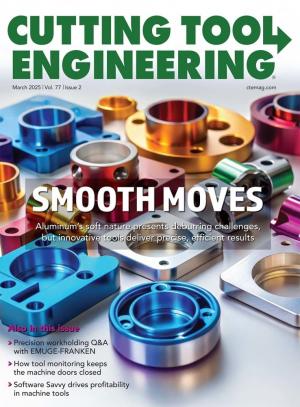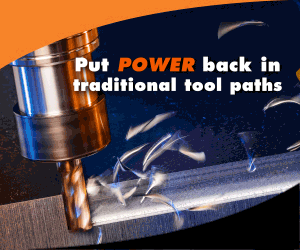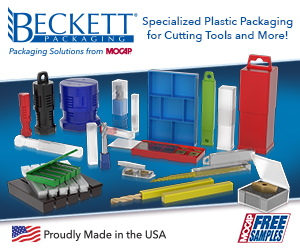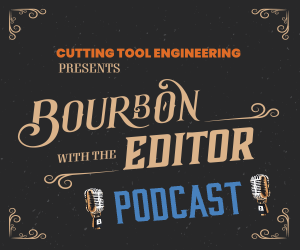Productivity in any pursuit is enhanced by working smarter. Using a feedback loop to gauge work in progress is a smart path to productivity. Another way is to identify and eliminate sources of error. A skilled man reading a micrometer and turning handles on a lathe has been a tried-and-true feedback loop for many years. Now there are ways to take the man out of the picture, potentially speeding up the process while eliminating the possibility of human error.
As computer power and data storage have become more affordable smart people have developed smarter ways to perform tasks that speed up processes and reduce errors — all to increase profitability. After all, my friends, increased Return On Investment is what this is all about.
When I was in engineering school in the 1960s, we communicated with a computer using IBM punch cards. The computer took up half of the floor space in a 40' x 100' room. We made mechanical drawings with a compass and T-square. When I went in the U.S. Army in 1969 during the Vietnam War, the Army used my communications skills to further its mission. The U.S. military had a program then called Zero Defects. Pay attention to what you are doing and don’t make mistakes. Using punch cards to transmit data eliminated the possibility of error caused by a human reading a text and typing a keyboard on a teletype machine. Reducing error is important when human lives are at risk. When I went to war I was assigned to a joint service unit in Thailand with men from all three branches of the U.S. military. There were 12 of us. I didn’t know it at the time, but when I stepped off of the airplane at Don Muang Airport near Bangkok I was done with the U.S. Army.
 Taylor’s Joint Service Commendation Medal
Taylor’s Joint Service Commendation Medal
My unit bunked on a U.S. Air Force base that was the home of the 388th Tactical Fighter Squadron. I was a cog in the Secret War run by the CIA in Laos. My weapon of choice was an IBM punch card machine. Near the end of my tour, I was promoted to Sargeant and given a Commendation Medal at the same time. Nice. The Army had a recruiting slogan then, Fun Travel and Adventure (FTA). I had fun and travel, and enough adventure to last a lifetime. For me there is nothing as exciting as the sound of a bullet passing by my ear. The photo is of my medal. ”Joint Service Commendation Medal presented for continuous heroic or meritorious service.” (DOD)
In the 1980s CNC metal working machines became affordable. Digital Equipment Company made computers to control those machines and Wang Labs made word processors for the office. People worked smarter and productivity went up.
I remember getting my first PC workstation running AutoCAD. It was a revelation. Soon I had a CAM program embedded in the CAD program and my productivity went up more. Making a human mistake in the code of a CNC part program can hurt a machine. It is kind of analogous to the Zero Defects program of my military experience.
In the first decade of the current century while working on one of my patents, my tasks included designing a microprocessor circuit and writing the program to control that microprocessor. The product was a smart actuator for an automotive application. The microprocessor read data from a sensor and controlled the position of a solenoid. The microprocessor had more computer power and storage than the computer I had used back in school, and had a footprint of 16 mm x 16 mm. Pretty cool at the time. Now our shops have many computer-controlled feedback loops because we need to work smart to be competitive. Working smart and working hard can augment each other. That has been my style since I was a short order cook in my high school days.
Related Glossary Terms
- computer numerical control ( CNC)
computer numerical control ( CNC)
Microprocessor-based controller dedicated to a machine tool that permits the creation or modification of parts. Programmed numerical control activates the machine’s servos and spindle drives and controls the various machining operations. See DNC, direct numerical control; NC, numerical control.
- computer-aided design ( CAD)
computer-aided design ( CAD)
Product-design functions performed with the help of computers and special software.
- computer-aided manufacturing ( CAM)
computer-aided manufacturing ( CAM)
Use of computers to control machining and manufacturing processes.
- lathe
lathe
Turning machine capable of sawing, milling, grinding, gear-cutting, drilling, reaming, boring, threading, facing, chamfering, grooving, knurling, spinning, parting, necking, taper-cutting, and cam- and eccentric-cutting, as well as step- and straight-turning. Comes in a variety of forms, ranging from manual to semiautomatic to fully automatic, with major types being engine lathes, turning and contouring lathes, turret lathes and numerical-control lathes. The engine lathe consists of a headstock and spindle, tailstock, bed, carriage (complete with apron) and cross slides. Features include gear- (speed) and feed-selector levers, toolpost, compound rest, lead screw and reversing lead screw, threading dial and rapid-traverse lever. Special lathe types include through-the-spindle, camshaft and crankshaft, brake drum and rotor, spinning and gun-barrel machines. Toolroom and bench lathes are used for precision work; the former for tool-and-die work and similar tasks, the latter for small workpieces (instruments, watches), normally without a power feed. Models are typically designated according to their “swing,” or the largest-diameter workpiece that can be rotated; bed length, or the distance between centers; and horsepower generated. See turning machine.
- micrometer
micrometer
A precision instrument with a spindle moved by a finely threaded screw that is used for measuring thickness and short lengths.
- turning
turning
Workpiece is held in a chuck, mounted on a face plate or secured between centers and rotated while a cutting tool, normally a single-point tool, is fed into it along its periphery or across its end or face. Takes the form of straight turning (cutting along the periphery of the workpiece); taper turning (creating a taper); step turning (turning different-size diameters on the same work); chamfering (beveling an edge or shoulder); facing (cutting on an end); turning threads (usually external but can be internal); roughing (high-volume metal removal); and finishing (final light cuts). Performed on lathes, turning centers, chucking machines, automatic screw machines and similar machines.








